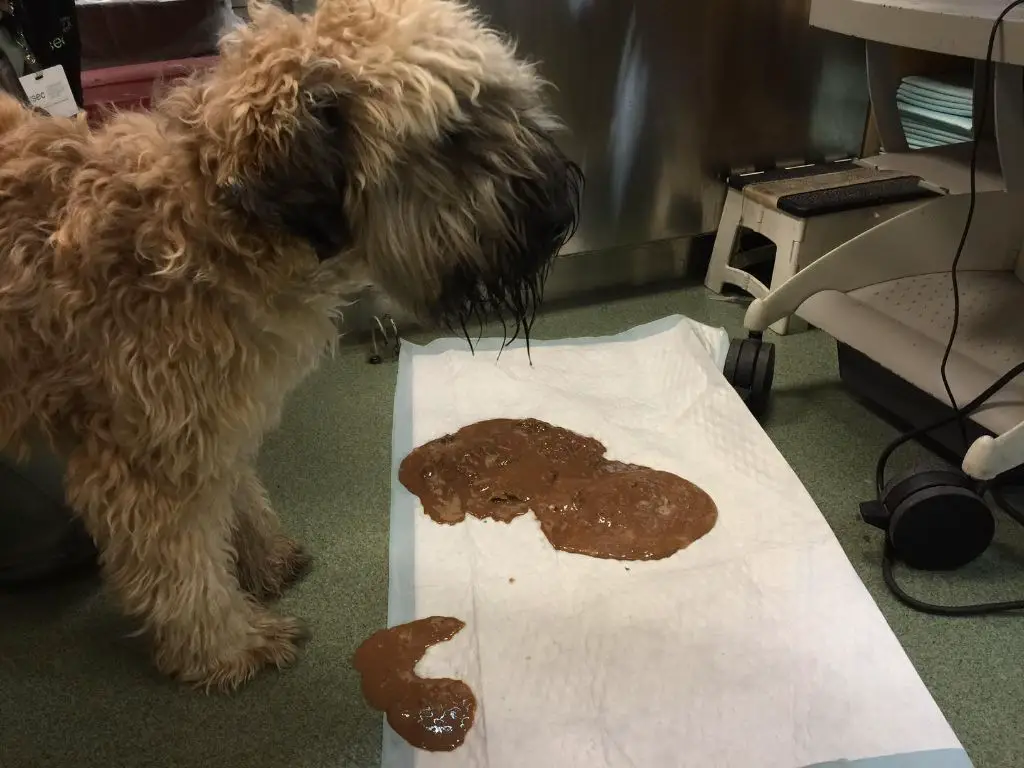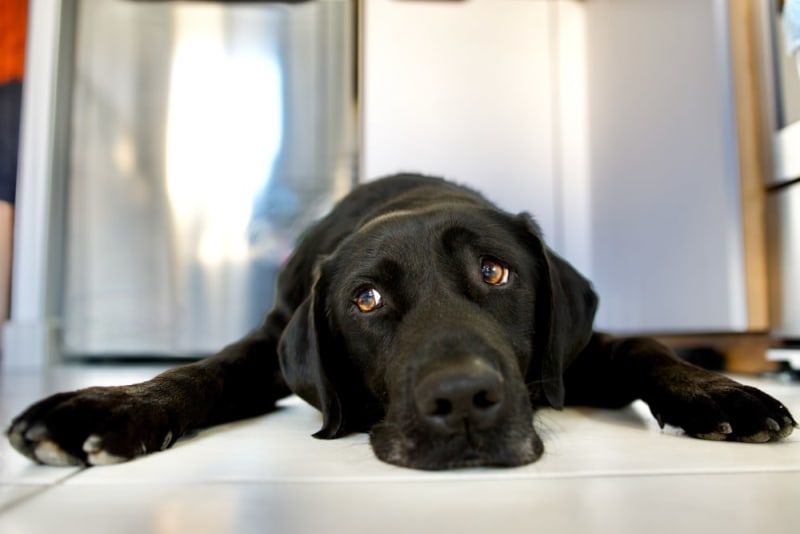Dangers of Dogs Eating Gum
Chewing gum poses two main dangers to dogs if ingested. First, many popular gum brands contain xylitol, an artificial sweetener that is highly toxic to dogs. Even small amounts of xylitol can cause a sudden drop in blood sugar, resulting in weakness, staggering, seizures, and liver damage. Just a few pieces of gum can be fatal to a small dog.
Second, chewing gum is designed not to break down easily. If swallowed, gum can cause blockages and obstructions in a dog’s digestive tract. Trying to pass large chunks of gum can lead to constipation, loss of appetite, vomiting, and intestinal damage. The amount consumed matters – one piece may pass through, but a whole pack can be life threatening.
Signs of Gum Poisoning

If your dog eats chewing gum, watch for these common signs of poisoning:
Vomiting – One of the first signs is vomiting. You may see pieces of gum in the vomit. Vomiting may begin within 30 minutes of ingestion.
Diarrhea – Diarrhea often follows vomiting. The diarrhea may be loose and watery or contain mucus.
Lethargy – As the toxins from the gum start to affect your dog, he may become tired and lethargic. He may be reluctant to move around.
Lack of appetite – A poisoned dog often loses interest in food and water. He may refuse his regular meals and treats.
Some or all of these symptoms may indicate your dog has gum poisoning. The symptoms often start within the first 12 hours after ingestion. Call your vet right away if you notice any of these signs after your dog got into gum.
When to See the Vet
If your dog ate a large quantity of gum or is showing signs of poisoning or blockage, you should take them to the vet right away. Some signs that require immediate veterinary attention include:
- Vomiting
- Diarrhea
- Abdominal pain or bloating
- Weakness or lethargy
- Drooling
- Loss of appetite
- Choking or gagging
- Trouble breathing
Dogs that ingest several pieces of gum or a whole pack are at greater risk for blockage or toxicity, so don’t wait to go to the emergency vet. The sooner gum is removed from the digestive tract, the better the outcome.
Treatment Options
If your dog eats a large amount of gum or shows signs of an intestinal blockage, the vet may induce vomiting to get the gum out of your dog’s stomach before it can cause further issues. This is done by injecting an emetic medication or giving your dog oral hydrogen peroxide.

Laxatives may also be prescribed to help clear any gum from your dog’s intestines. The vet will give the appropriate laxative based on your dog’s size and symptoms.
IV fluids help flush toxins from your dog’s system and prevent dehydration. Your dog may need to stay at the vet clinic for a day or two on IV fluids if vomiting, diarrhea or lack of appetite are present.
In severe cases where a blockage occurs, surgery may be required to manually remove the obstruction. This carries risks of anesthesia and infection, so it’s only used when absolutely necessary.
Preventing Gum Eating
The best way to prevent your dog from ingesting gum is to keep all gum and gum products safely out of your dog’s reach. Gum should be kept in closed bags or containers on high shelves or cabinets your dog cannot access. Do not leave individual wrapped pieces of gum anywhere your dog could get to it. Dogs are sneakily good at snatching things you wouldn’t expect them to get!
It’s also important to train your dog to ‘leave it’ when they encounter something they should not eat. Practice the ‘leave it’ command regularly with treats and toys so they learn not to touch items unless you give them permission. This command could prevent gum eating and keep them safe.
You can also use bitter apple sprays and chew deterrents designed to curb chewing and make unwanted objects unappealing. Apply these deterrents to any tempting items your dog may mistakenly chew on. The bitter taste helps teach them to avoid chewing those items in the future.
Gum Brands to Avoid
Sugar-free gum brands containing xylitol should be avoided at all costs. Xylitol is an artificial sweetener that is extremely toxic to dogs. Even small amounts of xylitol can cause hypoglycemia, liver failure, and even death in dogs.
Some popular gum brands to keep away from dogs include:
- Trident
- Orbit
- Ice Breakers
- Eclipse
- Excel
- Stride
- Pur
- Freedent
Be sure to check the ingredient list for xylitol before giving any gum or candy to dogs. It’s also wise to keep all gum up and away where dogs cannot access it. The consequences of a dog eating sugar-free gum with xylitol can be severe, so it’s best to avoid those products altogether.
Safer Chewing Options
When looking for safer alternatives to regular chewing gum, there are several dog-friendly options to consider that can satisfy your pup’s desire to chew while also promoting better dental health:
Dental chews – These are specially formulated chews made to help scrape away plaque and tartar as your dog gnaws on them. The mechanical action of chewing helps clean their teeth. Look for brands with the VOHC (Veterinary Oral Health Council) seal of approval.

Bully sticks – These popular chews are made from free-range cattle and are a tasty, long-lasting chew. The chewing action promotes saliva production which helps keep teeth clean. Opt for single-ingredient bully sticks with no artificial flavors or preservatives.
Kongs – You can stuff peanut butter, wet food or treats into a Kong toy and let your dog lick away. The licking and chewing motion exercises their jaws and cleans teeth. Use Kongs designed specifically for aggressive chewers if needed.
Rotate different chews to keep your dog interested and provide variety. Always supervise them when chewing any treat and take it away once it gets small enough to swallow. With the right chew toys, you can keep your dog happily occupied while also benefiting their dental health.
Teaching Your Dog
One of the best ways to prevent your dog from eating gum is to teach them not to take food or objects off the ground. This is done through positive reinforcement training.
Start by teaching your dog the “leave it” cue. Show them a treat in your hand, then cover it with your other hand and say “leave it.” When your dog stops trying to get the treat, praise them and give them a different treat from your other hand as a reward.
Practice this exercise regularly, gradually working up to dropping treats on the floor and asking your dog to leave them. Reward them with an alternative treat when they listen. Over time, your dog will learn not to touch food or objects until you give them permission.
It’s also helpful to teach your dog the “drop it” command. Show them a toy, let them take it, then say “drop it” and swap the toy for a treat when they comply. This allows you to ask them to release an unsafe object if they pick it up.
Use distraction and redirection when you see your dog going for gum. Call their name, ask for a simple command like “sit,” then reward them. This builds the habit of looking to you rather than scavenging prohibited items.
With positive reinforcement training, you can teach your dog to avoid chewing gum and other tempting but dangerous objects they may find on the ground or floor.
Acting Fast Matters
When a dog eats gum containing xylitol, it’s crucial to act quickly. The toxic effects of xylitol can cause a rapid drop in blood sugar, vomiting, seizures, liver failure, and even death if left untreated. Minutes and hours can make a big difference.
If you see your dog eat gum or even suspect it, call your vet or an emergency pet hospital right away. Be ready to describe the type and amount of gum consumed, your dog’s symptoms, and when it happened. Your vet will advise you on inducing vomiting at home or bringing your dog in immediately.

Quick action allows vets to provide glucose supplements, activated charcoal, and IV fluids to stabilize blood sugar, absorb toxins, and protect the liver. The sooner treatment begins, the better the chance of preventing long-term effects or even death.
Don’t wait to see if symptoms appear. Take swift action as soon as ingestion occurs or is suspected. Your dog’s survival could depend on timely treatment in the critical hours after consuming gum containing xylitol.
Most Dogs Recover
In most cases, dogs will make a full recovery if gum ingestion is treated promptly. The key is to get veterinary care as soon as possible after the ingestion occurs. Many common symptoms like vomiting, diarrhea and lethargy are temporary effects that will resolve on their own once the gum has passed through the dog’s system.
With quick treatment before the xylitol is fully absorbed, there is often no lasting damage. Your vet may induce vomiting to flush out any remaining gum, and give IV fluids or medication to control blood sugar and protect the liver. They will monitor electrolyte levels and watch for signs of liver failure. However, complete recovery within a few days is the most common outcome when gum ingestion is addressed rapidly.
While any ingestion of gum should be taken seriously, try not to panic. Focus on getting to the vet right away. Then follow their treatment plan to nurse your dog back to full health. With prompt veterinary care, most dogs make a quick and complete recovery after eating gum.